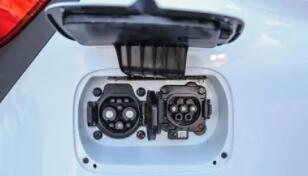The prosperity of electric vehicles has led to a sharp increase in demand for plastic for charging infrastructure. Langsheng firmly believes that this field provides opportunities for the extensive use of its Duriton polyamide and Pocan polyester. The new design concept of Langsheng's charging inlet showcases the possibility of obtaining these thermoplastic compounds. They are installed in pure electric vehicles and accommodate charging couplers for external charging stations.

General view of the charging port. Its design purpose is to use direct current and alternating current to charge vehicle batteries. Photo: Langsheng
Gregor Jaschkewitz, an application developer in the High Performance Materials (HPM) business, explained, "Our approach aims to use modular configurations to obtain the correct materials in the correct locations, meeting the complex requirements applicable to various components with the highest accuracy. Design the unit of this design
The new EV charging port has the following characteristics:
Modular design based on customized material solutions;
Pay attention to material characteristics and optimize costs;
Screwless assembly with integrated fasteners;
Keep the number of components to a minimum;
High flexibility in selecting seals.

This design is a product of collaborative discussions with charging system manufacturers, integrating the experience accumulated by Langsheng in numerous charging infrastructure development projects.
This means that it also meets the desire expressed by many manufacturers to be as flexible as possible in terms of charging inlet sealing, "Jaschkewitz said.
O-rings, sealing ropes, or series seals can be used, for example, lip shaped seals manufactured using a two component injection molding process.
The key elements of this charging port design are the front and rear shells, the sockets of the charging station connectors, and the actuators. The latter locks the connector in place to prevent it from being accidentally or intentionally pulled out during charging. Pin seat is another fundamental element. It fixes metal connector pins in place, as well as printed circuit boards (PCBs) with cables for DC or AC charging, and so on. The design of the needle holder has received special attention. It positions the cables so that the heat generated during the charging process is not only dissipated through them, but also through other unused cables.
This means that the needle holder supports thermal management, making it easier to charge quickly at high currents, "Jaschkewitz said.
After placing the cable and contact pin into the bracket and clamping them into the PCB, all charging inlet components will be assembled together with the help of a buckle. The cables are fixed in place at minimum strain, so they do not separate in the casing. Jaschkewitz: "The ability to connect components without screws simplifies the assembly process and related logistics, thereby reducing manufacturing costs
The plastic used for the charging inlet must comply with the IEC 62196-1 standard and provide high electrical insulation resistance, high dielectric strength, and resistance to electrical traces. Good flame retardancy is also essential. Components in direct contact with live components must pass the Glow Wire Final Product Test (GWEPT) in accordance with IEC 60695-2-11, with a Glow Wire ignition temperature of 850 ° C. After 7 days of storage at 80 ° C, plastic components must not exhibit any surface changes caused by aging, such as cracks. Advanced mechanical properties (such as good toughness) are also required to ensure that the charging inlet is not susceptible to collision or intentional damage.
Our material solutions include compounds that are very suitable for this range of requirements. In some cases, we also offer versions specifically developed for electric vehicles, "said Sarah Luers, an application developer at HPM For example, this includes products that are highly weather resistant and UV resistant for enclosures, as well as materials with low shrinkage and warpage for components that require special dimensional stability. Thermal conductive polyamide 6 compounds with good mechanical properties are designed for use in pin retainers that withstand heavy heat loads. This also includes product types that have passed UL 94 flammability testing and obtained V-0 rating as specified by the Underwriters Laboratories testing agency in the United States. For external use The highly weather resistant and UV resistant products of the shell, as well as materials with low shrinkage and warpage for components that require special dimensional stability
Langsheng provides a wide range of services to charging system manufacturers through its HiAnt service brand. For example, it represents its project partners in calculating and simulating how component geometry and materials will affect heat generation in the component. Other services include conducting important flammability tests that meet standards and conducting mechanical tests, such as ball drop testing.
Langsheng is currently considering applying the new design to further assembly of charging infrastructure, such as charging plugs. Due to the very similar requirements, the design and material expertise accumulated during the operation of the vehicle charging inlet can be largely deployed here.











